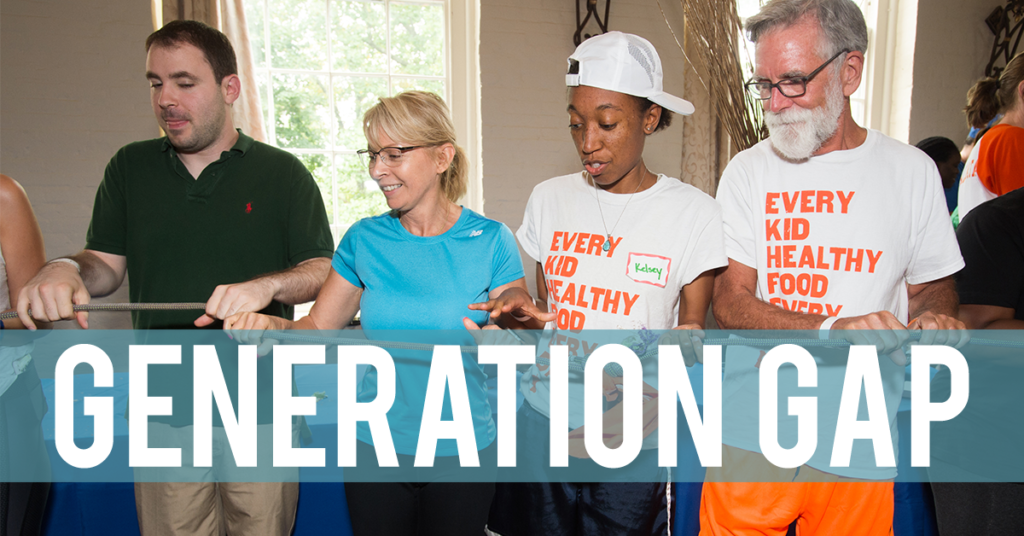Raise your hand if you’ve ever heard a joke about Millenials (adults ages 20 to 36). Love them or hate them, Millenials make up a large portion of today’s workforce. In fact, in 2015, Millenials surpassed Generation X and Baby Boomers as the largest generation in the workplace. Perhaps now more than ever before, the workplace is a multi-generational melting pot, which can certainly put a strain on management.
“Diversity can breed conflict, and today’s work teams are more generationally diverse than ever,” says Katie Morell, Meetings Today. “In any one company there may be people from four different generations working together, all with different career ethics, goals and values.”
However, when a multi-generational workforce can also be a big advantage.
Bridging the Generation Gap
“Maximize the value of generational differences and you can realize the potential and success of experience meeting youthful innovation,”says Kate Nasser, The People Skills Coach™.
Open the Lines of Communication
According to a study by TriNet, 74 percent of Millenials feel “in the dark” about how their managers and peers think they’re performing. This leads to anxiety, increased absences from work, and poor communication. However, the solution is quite simple – transparency. If your employees, regardless of age, feel comfortable communicating their expectations with their peers, productivity will not only increase, but also overall team morale.
“A lot of companies come to me saying they are not communicating effectively, but when I take a closer look, I realize those issues are related to generational clash points,” says Wayne Bennett, president of TeamWorx Team Building LLC in California.
And it is important to note that workers from different generations may communicate differently. So, it is important to be flexible (which we will also touch on later).
“The generations often have their preferred methods of communication,” according to MindTools.com. “Boomers tend to use one-on-one, telephone or written communication, whereas Generations X and [Millenials] tend to like emails and texts. Generations differ in the degree of formality they use, too. Older team members tend to be more formal, whereas their younger colleagues will more likely use colloquialisms, abbreviations.”
Avoid Stereotyping
This goes back to the very first line in this article. Stereotypes are sometimes unavoidable and also result in some less-than-thoughtful jokes about generalized populations of people. In the workplace, however, it is important to try and avoid stereotypes. No one individual can be (or should be) defined by the year they were born.
“Everyone is unique so, instead of assuming the worst, fight your unconscious bias and accept individuals based on their merits, rather than as ‘typical’ members of particular generations,” advises MindTools.com.
Be Flexible & Learn from One Another
“Each generation has its wants and needs, and values different ways of working,” according to MindTools.com. As we mentioned earlier, it is important to be flexible and open to new ways of thinking. You can learn a lot from your co-workers, especially those who may have a different way of working than you.
“Employers with a generationally diverse workforce benefit from having access to employees with a broad set of skills and experience,” according to Robert Half. Be a sponge and absorb all you can.
“The different generations have a wealth of knowledge and experience that they can share,” says MindTools.com. “The Boomers in your team, for example, can pass on the knowledge, information, useful contacts, and perspectives that they have developed during their years at work. In return, a Generation Y (Millenial) colleague can help them to get to grips with recent innovations, such as the latest developments in social media and viral marketing.”
Get Out of the Office
“Millennials have shown us the importance of building strong teams through activities outside of the office,” says Lynn Flinn, CPA, president and managing partner of The Rowland Group of Staffing Companies. “Most of us are too busy during the work day to take time to talk or get to know much about our co-workers, and these functions allow us to socialize and learn more about others on our team.”
Team Building Programs Bring Generations Together
So, how do you bring so many different ideologies together to form one cohesive, well-oiled unit? Team Building!
“When done well, team-building activities can…help build better relationships and increase communication among your team members,” says Flinn.
Terrapin Adventures is able to create a customized program (onsite or offsite, indoor or outdoor) to help bridge the generation gap and streamline your workforce. After each exercise, your group will sit down with their facilitator to discuss the lessons behind each activity and how they translate to the business world. This discussion is designed to reinforce these lessons and help ensure that the progress made during your team building outing sticks.
Schedule Your Custom Team Building Program!
Team building can be done year round as Terrapin Adventures has team building suites where we use our portable equipment and creativity to engage with teams on fun and meaningful exercises.
If you have any questions, please call Terrapin Adventure at 301.725.1313, or email us at info@terrapinadventures.com to learn more.
Works Cited
- “9 Statistics Employers Should Know About Millennials | Masterson Staffing.” Masterson Staffing Solutions, 9 Nov. 2017, www.mastersonstaffing.com/blog/9-interesting-statistics-about-millennials/.
- Flinn, Lynn . “Leader 2 Leader: If millennials teach us anything, it’s that team-Building events are important.” Tulsa World, 18 Jan. 2018, www.tulsaworld.com/business/tulsabusiness/leader-leader-if-millennials-teach-us-anything-it-s-that/article_9703650b-4bec-50e9-99f4-f8673924c7e4.html.
- Fry, Richard. “Millennials surpass Gen Xers as the largest generation in U.S. labor force.” Pew Research Center, 11 May 2015, www.pewresearch.org/fact-tank/2015/05/11/millennials-surpass-gen-xers-as-the-largest-generation-in-u-s-labor-force/.
- Nasser, Kate. “Team Building Across Generations – Proven Approach | #leadership – Kate Nasser.” KateNasser.com, 22 Nov. 2015, katenasser.com/team-building-across-generations-%E2%80%93-proven-approach/.
- “The Key to Managing a Multigenerational Team: Don’t Overthink It.” Robert Half, 15 Nov. 2017, www.roberthalf.com/blog/management-tips/the-key-to-managing-a-multigenerational-team-dont-overthink-it.

